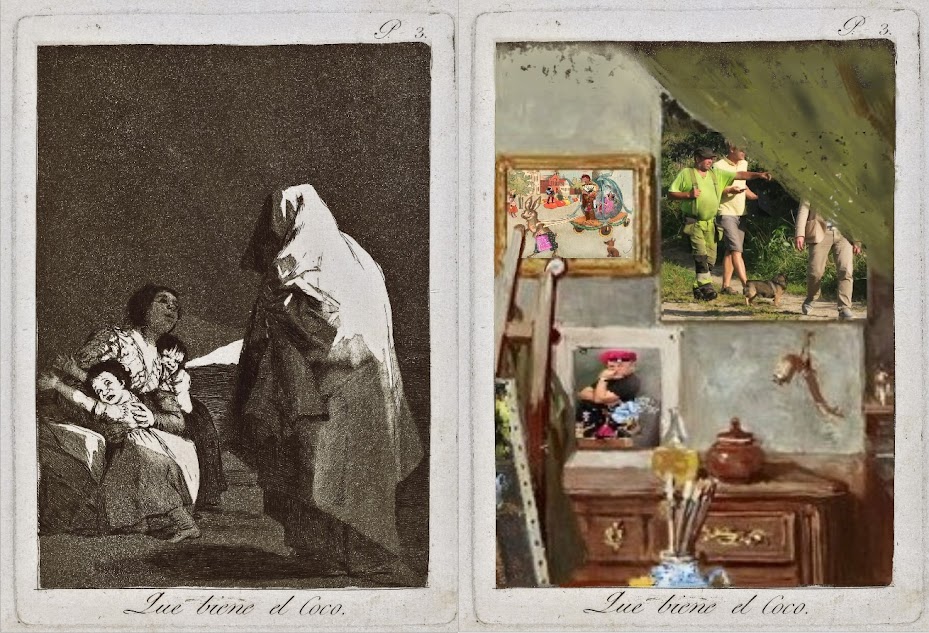PK_SP_074 QUE VIENE EL COCO / BUGABOO
Once upon a time, in the misty marshlands of language, there lurked a host of shadowy creatures—sprites, goblins, and monsters—whose sole purpose was to startle, spook, and sometimes even discipline the wayward children of Europe.
Among these nocturnal mischief-makers was the infamous 𝒃𝒐𝒈𝒆𝒚𝒎𝒂𝒏, a shapeshifting terror whispered about in countless nurseries. The 𝒃𝒐𝒈𝒆𝒚𝒎𝒂𝒏 had many names and forms: the Scots called him the 𝒃𝒐𝒈𝒍𝒆, the Welsh knew him as 𝒃𝒘𝒈, and in the dark corners of England, he was the 𝒃𝒖𝒈𝒃𝒆𝒂𝒓—a monstrous bear-like demon said to gobble up naughty children.
But language, like the 𝒃𝒐𝒈𝒆𝒚𝒎𝒂𝒏 himself, is ever-changing and full of surprises. One day, from the tangled roots of these words, a new creature emerged: the 𝒃𝒖𝒈𝒂𝒃𝒐𝒐. Some say the 𝒃𝒖𝒈𝒂𝒃𝒐𝒐 was born in Scotland, where the word 𝒃𝒐𝒈𝒊𝒍𝒍 meant 𝒈𝒐𝒃𝒍𝒊𝒏 or 𝒃𝒖𝒈𝒃𝒆𝒂𝒓. Others trace its ancestry to the Old French poem 𝑨𝒍𝒊𝒔𝒄𝒂𝒏𝒔 (1141), where a demon named 𝑩𝒖𝒈𝒊𝒃𝒖 prowled. Still others suspect a Celtic connection, with the Cornish 𝒃𝒖𝒄𝒄𝒂-𝒃𝒐𝒐 (from 𝒃𝒖𝒄𝒄𝒂 meaning 𝒈𝒐𝒃𝒍𝒊𝒏 or 𝒅𝒆𝒗𝒊𝒍) joining the family tree.
The 𝒃𝒖𝒈𝒂𝒃𝒐𝒐 was a master of disguise. Sometimes it was a goblin, sometimes a ghost, and sometimes just an imagined terror—an object of dread conjured to keep children in line or to explain away the bumps in the night. In the 18th century, it could even be found haunting the pages of dictionaries, defined as a “bugbear to fright children” or an “ugly wide-mouthed picture” paraded about during May games.
As centuries passed, the 𝒃𝒖𝒈𝒂𝒃𝒐𝒐 lost much of its monstrous menace, transforming into a metaphor for any persistent worry, anxiety, or obstacle—be it a looming exam or an outdated superstition. Yet, its roots remain tangled with the 𝒃𝒐𝒈𝒆𝒚𝒎𝒂𝒏 and his spectral kin, all springing from the same fertile soil of folklore and fear.
And so, the 𝒃𝒖𝒈𝒂𝒃𝒐𝒐 lives on—not just as a nursery sprite or a shadowy fiend, but as a whimsical reminder that the monsters we fear are often the ones we invent.
𝑭𝒆𝒂𝒕𝒖𝒓𝒆𝒅 𝑨𝒓𝒕𝒊𝒔𝒕: Francisco Goya (1746-1828), Spanish painter and printmaker, “Here Comes the Bogeyman” (Que viene el Coco), etching from the series “Los Caprichos” (1797-1799), ©Museo Nacional del Prado
Goya’s etching shows a mother frightening her children with the figure of “El Coco”—the Spanish bogeyman—a blanketed, spectral figure looming in the foreground. The work critiques the use of such bugaboos in child-rearing, highlighting how imaginary terrors are used to control children’s behavior. Through this scene, Goya reflects Enlightenment concerns about superstition and the psychological harm caused by instilling irrational fears in children.



Kommentaarid
Postita kommentaar